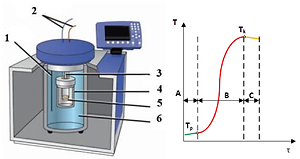Current issue
Online first
Archive
About the Journal
Aims and scope
Publisher and Editorial
Advertising policy
For Authors
Paper review procedures
Procedures protecting authentic authorship of papers
Paper preparation manual
Plagiarism check
Publication ethics
Reviewers
APC
Editorial and Scientific Board
Contact
Reviewers
Methodology for determining the elemental composition, as well as energy and ignition properties of the low-sulfur marine fuels
1
Marine Power Plants, Gdańsk University of Technology, Poland
Submission date: 2021-07-03
Final revision date: 2021-08-24
Acceptance date: 2021-08-24
Online publication date: 2021-08-25
Publication date: 2021-09-13
Corresponding author
Combustion Engines 2021,186(3), 96-102
KEYWORDS
TOPICS
ABSTRACT
The key metrological issue of substance and energy balance in research engines is the precise determination of the ele-mental composition of the applied fuel and its net calorific value. This makes it possible to calculate the amount of heat brought with the fuel into the combustion chamber, as well as the amount and gas composition of the exhaust. However, to fully assess the energy quality of the fuel used, its ignition properties should also be estimated. They determine the combustion kinetics and, consequently, the course of gas pressure alterations and heat release in the cylinder, which have a direct impact on the indicated power and thermal efficiency of the engine.
This article presents the methodology for carrying out this type of laboratory tests and their representative results con-cerning six different low-sulfur marine fuels used to feed marine engines at present. The considerations focus mainly on measurement technology, as well as the measuring apparatus applied today. Additionally some existing metrological difficulties that might be met were shortly described. The laboratory tests in question stand for the first stage of the program of testing a new kind of low-sulfur marine fuels in real operating conditions of a diesel engine, which was carried out at the Department of Ship Power Plants of the Gdańsk University of Technology.
REFERENCES (20)
1.
ARMAS, I.P., VALENCIA, F.A. Ignition quality of residual fuel oils. Journal of Maritime Research. 2005, II(3), 77-96.
2.
BOCZKAJ, G., KAMIŃSKI, M. Gas chromatography with selective detection in analytics of sulfur and nitrogen volatile compounds. Camera separatoria. 2011, 3(1), 51-67.
3.
DYBICH, K. Zasada metody oznaczania liczby cetanowej próbek paliw silnikowych na stanowisku badawczym z sil-nikiem Dresser Waukesha CFR (USA). Nafta-Gaz. 2012, 1, 84-87.
4.
DYBICH, K. Problemy eksploatacyjne silników badawczych CFR Waukesha. Nafta-Gaz. 2011, 6, 417-420.
5.
GROB, R.L., BARRY, E.F. Modern practice of gas chroma-tography. 4th edition, John Wiley & Sons Inc. New Jersey 2004.
6.
JĘDRYCHOWSKA, S., WIECZOREK, A. Analiza wielo-pierwiastkowa środków smarowych z wykorzystaniem tech-niki spektrometrii fluorescencji rentgenowskiej z dyspersją fali. Nafta-Gaz. 2013, 6, 476-485.
7.
KORCZEWSKI, Z. et al. Analiza wpływu właściwości paliw żeglugowych na charakterystykę energetyczną silnika Diesla, niezawodność jego pracy i zużycie części. Praca n-b nr 4600009272 (zleceniodawca – LOTOS Group S.A.), Poli-technika Gdańska, Gdańsk 2019.
8.
KORCZEWSKI, Z. et al. Metoda oceny skutków ekologicz-nych, energetycznych i niezawodnościowych stosowania modyfikowanych paliw okrętowych do zasilania silników Diesla w warunkach rzeczywistych. Praca n-b nr RX-10/2017 współfinansowana przez wojewódzki Fundusz Ochrony Środowiska i Gospodarki Morskiej w Gdańsku. Politechnika Gdańska, Gdańsk 2019.
9.
KORCZEWSKI, Z. Diagnostyka eksploatacyjna okrętowych silników spalinowych – tłokowych i turbinowych. Wybrane zagadnienia. Wydawnictwo Politechniki Gdańskiej, Gdańsk 2017.
10.
WIŚNIEWSKI, S. Pomiary temperatury w badaniach silni-ków i urządzeń cieplnych. Wydawnictwa Naukowo-Techniczne, Warszawa 1983.
11.
WIŚNIEWSKI, S. Termodynamika techniczna. Wydawnictwa Naukowo-Techniczne, Warszawa 2005.
12.
ASTM D5291-16 Standard test method for instrumental determination of carbon, hydrogen and nitrogen in petroleum products and lubricants.
13.
ASTM D2622-16 Standard test method for-sulfur in petro-leum products by wavelength dispersive X-ray fluorescence spectrometry.
14.
ASTM. D613-10a Standard test method for cetane number of diesel fuel oil; ASTM International: West Conshohocken.
15.
PN-EN ISO 5165:1998 Przetwory naftowe – oznaczanie właściwości zapłonowych olejów napędowych – metoda sil-nikowa oznaczania liczby cetanowej.
16.
PN-EN ISO 5165:2003 Przetwory naftowe oznaczanie właściwości zapłonowych olejów napędowych – metoda sil-nikowa oznaczania liczby cetanowej.
17.
PN-86/C-04062 Przetwory naftowe. oznaczanie ciepła spalania paliw ciekłych w bombie kalometrycznej i obliczanie wartości opałowej.
CITATIONS (4):
1.
Determination of Cetane Number from Fatty Acid Compositions and Structures of Biodiesel
Cherng-Yuan Lin, Xin-En Wu
Processes
Cherng-Yuan Lin, Xin-En Wu
Processes
2.
Method to identify fuel sulphur content (FSC) violations of ongoing vessels using CFD modelling
N. Rapkos, A. Weigelt, J. Beecken, L. Ntziachristos
Atmospheric Environment
N. Rapkos, A. Weigelt, J. Beecken, L. Ntziachristos
Atmospheric Environment
3.
Adoption of the F-statistic of Fisher-Snedecor distribution to analyze importance of impact of modifications of injector opening pressure of a compression ignition engine on specific enthalpy value of exhaust gas flow
Patrycja Puzdrowska
Combustion Engines
Patrycja Puzdrowska
Combustion Engines
4.
The effect of hydrostatic pressure on the activity and community composition of hydrocarbon-degrading bacteria in Arctic seawater
Angeliki Marietou, Jennie Schmidt, Martin Rasmussen, Alberto Scoma, Søren Rysgaard, Leendert Vergeynst, Marina Lotti
Applied and Environmental Microbiology
Angeliki Marietou, Jennie Schmidt, Martin Rasmussen, Alberto Scoma, Søren Rysgaard, Leendert Vergeynst, Marina Lotti
Applied and Environmental Microbiology
We process personal data collected when visiting the website. The function of obtaining information about users and their behavior is carried out by voluntarily entered information in forms and saving cookies in end devices. Data, including cookies, are used to provide services, improve the user experience and to analyze the traffic in accordance with the Privacy policy. Data are also collected and processed by Google Analytics tool (more).
You can change cookies settings in your browser. Restricted use of cookies in the browser configuration may affect some functionalities of the website.
You can change cookies settings in your browser. Restricted use of cookies in the browser configuration may affect some functionalities of the website.



